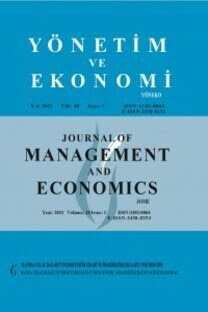Demir-Çelik Sektörünün Küresel Rekabet, Ekonomik Büyüme Ve İşsizlik Üzerine Etkileri
Çelik, Rekabet, Küreselleşme, Toda-Yamamoto Nedensellik Analizi, PMG Tahmincisi
Effects Of Iron-Steel Sector On Global Competıtıon, Economıc Growth And Unemployment
Steel, Competition, Globalization, Toda-Yamamoto Causality Analysis, PMG Estimator,
___
- Akçay, A.Ö. ve Erataş, F. (2012). Assessment of the current account defıcıt and economıc growth relatıonshıp wıthın axıs of the panel causalıty analysıs, (pp. 1-24), İzmir: International Conference on Economics, Turkish Economic Association
- Atalay M. and Turhan M., (2002). Küreselleşme, Gelişmekte Olan Ülkeler ve Türk İmalat Sanayii, Planlama Dergisi, Özel Sayı (DPT’nin Kuruluşunun 42. Yılı), 77-110.
- Aydemir C. and Kaya M. (2007). The globalization concept and ıts economical side, Electronic Journal of Social Science, 6(20), 260-282.
- Bakırcı, F., Eslamian, S. S. and Sattary, A. (2014). Financial performance analysis of ıron, steel metal ındustry sector companies in the borsa İstanbul: DEA Super Efficiency and TOPSIS Methods, Ege Academıc Revıew, 14(1), 9-19.
- Chang, C.P. and Lee C.C. (2010). Globalization and economic growth: A political economy analysis for OECD countries, Global Economic Review, 39(2), 151-173.
- Chang C.P., Lee C.C. and Hsieh M.C. (2011). Globalization, real output and multiple structural breaks, Global Economic Review, 40(4), 421-424.
- Çeştepe, H. and Tunçel, A. (2018). Internatıonal competitiveness analysis of the Turkish ıron and steel sector, Turkish Studies, International Congress on Social Sciences II (INCSOS 2018 Quds) Academic Journal, 13(15), 113-129.
- Demir G. 2001, On the globalization, Ankara University Journal of Political Science Faculty, 56(1), 73-104.
- Dikkaya M. and Deniz F. (2006), The problems of economıc globalization: a theoritical approach, International Journal of Management Economics and Business, 3(2), 163-181.
- Dilek S. (2016), Oyun Teorisi Eşliğinde Sanayi Ekonomisi, Ankara: Seçkin.
- Dünya Çelik Üretim Raporu (2017) http://www.demircelik.com.tr/-1-9249-dunya-celik-uretim-raporu-mart-2017.html(Accessed 12 March, 2017)
- Ersöz, T., Düğenci, M., Ünver, M. and Eyiol, B. (2015). A general overview of the ıron and steel sector and an examination of over five million tons of ıron and steel exporting countries by the cluster analysis, Nevsehir Journal of Science and Technology, 4(2), 75-90.
- Ersöz, F.; Ersöz, T. ve Erkmen, İ. N. (2016). Overview of crude steel production in Turkey and the world, Erciyes University Journal of Institue Of Science and Technology, 32(2), 1-12.
- Kara, O. and Erkan, B. (2016, October). The Relationship of Productivity and Comparative Advantage in The Iron-Steel Industry, Turkısh Economıc Assocıatıon Internatıonal Conference On Economıcs Ice-Tea 2016 (pp. 1222-1243), Bodrum: International Conference on Economics, Turkish Economic Association, ICE-TEA 2016, Erişim Adresi : https://www.researchgate.net/publication/317290055
- Kravec, M. and Slivková, A. (2013), Cluster analysis of steel ındustry, International Journal of Interdisciplinarity In Theory And Practice, (2), 110-117.
- Özcan, A. İ. ve Anıl, N.K. (2017). Efficiency measurement of firms among the biggest 500 firms operating ın ıron & steel ındustry by dea and malmquist, Kırklareli Üniversitesi İktisadi ve İdari Bilimler Fakültesi Dergisi, 6(1), 112-120.
- Pesaran, M. H. and Yamagata, T. (2008). Testing slope homogeneity in large panels, Journal of Econometrics, 142(1), 50–93.
- Schwab, K. (2016), The Global Competitiveness Report 2016–2017, World Economic Forum, Geneva: Insight Report.
- Türkiye Odalar ve Borsalar Birliği (TOBB), (2014). Türkiye Demir ve Demirdışı Metaller Meclisi Sektör Raporu-2013, Ankara: TOBB Yayın No: 2014/221, pg. 7-98.
- Turgut, B. (2016). Erdemir Grubu: 2016 Yılında küresel çelik sektöründe dengelenme ve normalleşme bekliyoruz, Journal of Prime, 108, 98-100.
- Türker, O. (2017). The change of the competitive power of Turkey’s ıron and steel ındustry for the period of 1989-2016, The Journal of Kesit Academy, 2(12), 54-77.
- Ülengin, F., Önsel, Ş., Karaata, S., Aktaş, E. Ve Kabak, Ö. (2010), Türkiye’nin Küresel Rekabet Düzeyi: Dünya Ekonomik Forumu Küresel Rekabet Raporuna Göre Bir Değerlendirme, İstanbul: TÜSİAD-Sabancı Üniversitesi Rekabet Forumu (REF) ve Sektörel Dernekler Federasyonu’nun (SEDEFED), 1. Basım.
- Worldsteel Association, (2016). Steel Statistical Yearbooks, http://www.worldsteel.com
- Worldsteel Association, (2017). Steel Statistical Yearbooks, http://www.worldsteel.com
- Yaşar O., (2009). A locomotive sector in Turkish manufacture ındustry: The ıron and steel ındustry, Journal of Marmara Geography, (20), 42-78.
- Yaşar, O. (2015). A research in the field of ındustrial geography: Iron-steel ındustry cluster in Hatay and Osmaniye provinces, Mediterranean Journal of Humanities, 5(1), 38-412
- Yavuz, V. A. and Demirci, S. (2014), An Empirical Analysis of The Efficiencies of Turkish Iron and Steel Companies During The Global Financial Crisis, Ed: Banker R. and others (Ed.), Data Envelopment Analysis and Performance Measurement: Proceedings of the 11th International Conference of DEA 2013 (p. 29-34) inside. Samsun: ISBN: 978 1 85449 477 1
- ISSN: 1302-0064
- Başlangıç: 1995
- Yayıncı: Manisa Celal Bayar Üniversitesi
Demir-Çelik Sektörünün Küresel Rekabet, Ekonomik Büyüme Ve İşsizlik Üzerine Etkileri
Application of Value Stream Mapping in a Manufacturing Firm in Bosnia and Herzegovina
Hilmi YÜKSEL, Zlatan Faik UZUNOVİĆ
Türkiye'de CO2, Turizm, Ekonomik Büyüme ve Dışa Açıklık İlişkilerin Araştırılması
Fısıltı Gazetesinin Yönetimi: Kamu ve Özel Sektör Yöneticileri Arasında Karşılaştırmalı Bir Uygulama
Beşeri Kalkınma, Sosyal Dışlanma ve Yoksulluk İlişkisi Üzerine Bir Değerlendirme
Avrupa Birliği Ülkeleri İle Türkiye’nin Ekonomik Göstergelerinin Karşılaştırılması
Türkiye İmalat Sanayinde Gelir Değişmeleri ve Boş Zaman Tercihleri İlişkisi
Aynur YILDIRIM, Gonca AKGÜN GÜNGÖR
Rusya’nın Türkiye’ye Yönelik Turizm Talebi: ARDL Sınır Testi Yaklaşımı (2002-2016)
Finansal Krizler Sonrası Uygulanan Regülasyonlar ve Etkinliği
